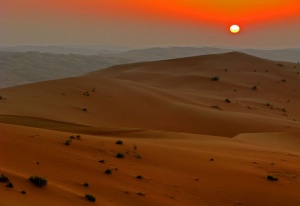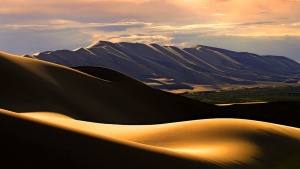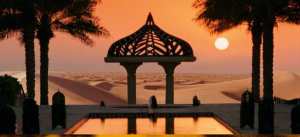More actions
m →Chi-ri |
|||
| Line 46: | Line 46: | ||
[[Image:Chi'ri.png|thumb|left|Rehr-halan Caravanserai]] | [[Image:Chi'ri.png|thumb|left|Rehr-halan Caravanserai]] | ||
Located in north-central Xial, Chi-ri was a walled fortress guarding the border that the nation shared with the Kingdom of Raal. At the crossroads of three trade routes, the fortress grew from a caravanserai famous for its palm trees and deep wells. Some of the old structures are still in use outside the main town - most famously the Rehr-halan (Three Journeys) hotel and museum, which is estimated to be seven thousand years old. | Located in north-central Xial, Chi-ri was a walled fortress guarding the border that the nation shared with the Kingdom of [[Raal]]. At the crossroads of three trade routes, the fortress grew from a caravanserai famous for its palm trees and deep wells. Some of the old structures are still in use outside the main town - most famously the Rehr-halan (Three Journeys) hotel and museum, which is estimated to be seven thousand years old. | ||
By Vulcan reckoning Chi-ri features some of the planet's finest examples of architectre, from the fine ornamental stone arcades of past centuries to the modern, sweeping styles that blend sandstone with glass and metal. | By Vulcan reckoning Chi-ri features some of the planet's finest examples of architectre, from the fine ornamental stone arcades of past centuries to the modern, sweeping styles that blend sandstone with glass and metal. | ||
Revision as of 10:37, 25 October 2015

Consisting mainly of equatorial desert, Xial (or Zhial, from anc. Zhih-g'lahn / blurred sight, mirage) is bordered by the Mountains of Gol to the South and the Arlanga Mountains to the North.
Despite the seemingly barren landscape, the flat plains below Arlanga are famous for their rich volcanic soil, and in recent centuries have become the "breadbasket of Vulcan". The thick deposits of tephra and volcanic loam in combination with extensive solar-powered farming complexes provide much of the food for the great cities of Regar and Shi'Kahr, as well as some exotic but much loved offworld delicacies such as Terran tomatoes and oranges, or Ktarian melons.
The arid wastes and shifting sands of central Xial are birthplace of many legends and myths of ancient Vulcan (and are indeed what most offworlders imagine the entire planet looks like). Natural phenomena that contribute to the myths of desert demons and spirits are the Sefla Uralay (singing dunes), and the electromagnetic storms that sometimes cross into Xial from Sas-a-Shar.
The foothills of the Heyalar t'Gol (Mountains of Gol) are home to hundreds of small, lovingly tended g'teth farms, providing a variety of beans for the famous Vulcan Mocha.
History

Inhabited mostly by nomadic tribes until well into the Age of Expansion, Xial was considered a kingdom only by virtue of the fertile regions in the shadow of the Arlanga Mountains, and is still the smallest province of Na'Nam.
While small settlements developed around oases near the mountains, the Herbosh'es Izayik (Shifting Desolation) at the center of Xial is the largest contiguous sand desert on the planet and remains largely uninhabited to this day. Sand dunes in Herbosh'es Izayik can reach heights of up to 300 meters, and fauna consists mostly of arachnids, rodents and snakes like the k'karee, which the dominant clan of Xial has adopted as its sigil beast.
Despite this seeming isolation the central desert of Xial was often hotly contested to secure trade routes between Raal and the rich Eastern kingdoms of Shi'Al and Kir, and the regions in the North were in an almost constant state of warfare with their Western neighbors.
Archaeological evidence points to the existence of an ancient Spice Route through the foothills of the Gol Mountains, and several forts guarding caravans from the nomadic desert tribes. One such fort near a pass towards Gol is considered one of the best preserved examples of 1st Dynasty architecture, and one of the oldest buildings on Vulcan that is still inhabited.
Places of Note
Seleya

Legend has it that "Heya" - the word that would come to mean "Mountain" - was the first word ever spoken on Vulcan when a wanderer first beheld the sight of Seleya rising from the white sands. Heya: an outward breath of surprise, a cry of delight on seeing something wonderful; in this case a mountain rising alone out of the distance, unchallenged by other peaks, impossibly high and forested almost to its summit. Still the tallest of all mountains on the planet, in its youth Seleya's uneroded peak still knew snow (and still holds underground caches of ancient water), and for millennia was an unmoving landmark around which Vulcan's turbulent history flowed.
Set on the very border to Shi'Al and the famous Forge, the 7000 meter peak of Seleya remains a lonely enclave, over 300 kilometers from the nearest settlement.
The priests of Seleya, whose traditions have always involved meditation and studies of the mind-body-katra connection, were the first to accept Surak’s teachings. Studying with the adepts of Seleya, Surak learned the mind-meld technique, a practice that was later banned in most Vulcan nations out of fear that it would resurrect the ancient horrors of mind control. But at Seleya, the mind-meld continued to be used in discreet healing techniques and in non-public rituals.
Pilgrims journeying to Seleya approached on foot, as they still do today, across the Forge from Shi'Kahr.
Reaching the temple complex requires crossing a narrow bridge – a natural rock formation – over a yawning chasm without the assistance of railings. The temple itself is located at the top of a winding staircase containing 1001 steps. An ancient fortress which has withstood numerous battles, the temple is a place of study and meditation today. Many traditional ceremonies take place at the base of the mountain within a sacred grove of ancient trees ringed by stone monoliths. The grove opens at one end into a natural amphitheater that ends at a raised dais with an altar of garnet-red stone.
The adepts of Seleya are considered the most skilled in Vulcan mind-arts, reputedly even able to perform the fal-tor-pan, the refusing of a katra with its body. Many precious Katric Arkkatric arks]] are kept at the temple, including Surak’s for a time.
Chi-ri

Located in north-central Xial, Chi-ri was a walled fortress guarding the border that the nation shared with the Kingdom of Raal. At the crossroads of three trade routes, the fortress grew from a caravanserai famous for its palm trees and deep wells. Some of the old structures are still in use outside the main town - most famously the Rehr-halan (Three Journeys) hotel and museum, which is estimated to be seven thousand years old.
By Vulcan reckoning Chi-ri features some of the planet's finest examples of architectre, from the fine ornamental stone arcades of past centuries to the modern, sweeping styles that blend sandstone with glass and metal.
The Subministry of Agriculture is located in Chi-ri, and the people who work or study there account for 15 000 of the roughly 75 000 residents.
